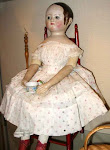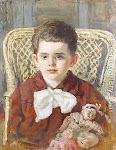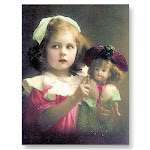
Johanna Maria Lind, born October 6, 1820 in Stockholm, Sweden, grew up as the daughter of a struggling single mother. Lind lived at various times with her mother in a shelter for indigent women. During those very lonely days, she developed the habit of singing to herself or to a pet cat she had.

Dolls with this typical type of hair style are called "Jenny Lind". Shoulder head made from glazed china, hairstyle with middle parting, wavy long hairstrands that stand out at the sides rather widely, combed to the rear and shaped into a wreath.
One day when she was nine, an attendant to a Stockholm ballet dancer heard Lind singing through a window. The dancer in turn brought Lind to the director of Sweden's Royal Opera, who equally surprised when he heard her sing. Lind was enrolled in the opera's training program, and those around her began to realize that Lind's talent was something special.

Never classically attractive, lacking confidence in herself, and generally seeming shy and quiet to people she met, Lind was an entirely different person on stage. "I awoke this morning as one person and retired in the evening as another."

Typical Jenny Lind style chignon

Alt, Beck and Gottschalk ca. 1870


Possibly A B & G... Jenny Lind doll ca. 1870's
 "La Sonnambula "
"La Sonnambula "
Lind embarked on an international career, and while performing in Copenhagen, Denmark, in 1843 attracted romantic attention from writer Hans Christian Andersen, an episode that was later turned into an opera of its own.

"Hans Christian Andersen", by Albrecth Jensen ca. 1836
Andersen often fell in love with unattainable women . One of his stories, "The Nightingale", was a written expression of his passion for Lind, and became the inspiration for her nickname, the "Swedish Nightingale". Andersen was often shy around women and had extreme difficulty in proposing to Lind. When Lind was boarding a train , Andersen gave Lind a letter of proposal. Her feelings towards him were not the same; she saw him as a brother, writing to him in 1844. farewell... God bless and protect my brother is the sincere wish of his affectionate sister, Jenny."

Jenny Lind by Alfred Lemon
Despite Lind’s respectable image, during the time she lived in Munich a prominent intellectual introduced her to Felix Mendelssohn, one of the greatest composers of the era. Despite Mendelssohn's happy marriage, the two shared a romantic attraction.

Jenny Lind as " MARIA, LA FIGLIA DEL REGGIMENTO" by Romage


Lind made her long-delayed English debut in May of 1847, before the cream of Victorian society, and went on to sing and to enchant Queen Victoria herself. It was in England, not America, that Jenny Lind mania really had its start.
But it took the fine art of American publicity to raise it to a new level.

Jenny Lind paper doll and trusseau
 "Snuff Box"
"Snuff Box"

"First Apperance Of Jenny Lind In America...Currier & Ives"

During the brief American phase of her career, between September of 1850 and May of 1852. Her trip to the United States was organized by the great showman Phineas T. Barnum, best remembered today by the circus that bears his name; He may never have had a greater triumph than his launch of Lind's tour. Tickets for her concerts reached astronomical prices, and her image soon adorned an incredible range of consumer items. Barnum profited handsomely, and Lind became perhaps the first person who could be described using the distinctly modern term "celebrity."


As Lind made triumphant appearances in New York and then toured the eastern seaboard and the cities along the Mississippi River, the British Jenny Lind mania was repeated and amplified. The later parts of her tour brought Lind one unexpected benefit; she married on February 5, 1855 and returned to Europe settling in Dresden, Germany. She had two sons and a daughter and by that time, the family had moved to Lind's beloved England.

Jenny Lind China shoulder head with cloth body, and leather lower arms...Possibly Conta Boehme.

The rest of her life was fairly quiet, although Lind numbered Queen Victoria and Prince Albert among their family friends. Living at first in the London suburb of Wimbledon, Lind later moved to the Malvern Hills in the rural Shropshire region. She suffered from cancer in the 1880s and died on November 2, 1887.
********************************************************
The Figurehead of a Nightingale

In 1851, the Nightingale left its berth place in Eliot, Maine. It was towed up to Boston, Mass.. Owners planned to use clipper to whisk 50 first-class passengers to the London World's Fair. In Boston the carved figurehead of a woman resembling the Swedish Nightingale, Jenny Lind was added. At least, that's what Karl-Eric Svardskog , antique collector believes.

Sold to owner after owner, the Nightingale was for a time the property of the United States Navy and used to haul coal. Then it was reduced to transporting lumber when it was finally abandoned off Norway in 1894. By this time both PT Barnum and Jenny Lind were dead. In 1994 antiques hunter Svardskog heard about the large wooden carving shaped like a woman that it was once used as a scarecrow.
He found it in a hayloft, one arm sticking out of the hay, where it had apparently lain for a century. Compelled to track down the origin of the life-sized ship's figurehead, Svardskog searched six years for clues to its origin.
In his research, Svardskog discovered that the Nightingale had actually been in the vicinity of the town where the figurehead was discovered. In 1874, workers had refit the ship in Norway nearby. The bow of the ship was damaged so it seemed that the Jenny Lind figurehead was removed during the repair work, and did not go down with the ship years later.

To say the antique dealer became obsessed with his wooden Jenny is no exaggeration. Like a modern day PT Barnum, Karl-Eric Svardskog brought the statue back to America in 2001, and after uncrating the heavy statue, Svardskog in gazed at the now familiar image. "She haunts me," he said. "She is like a ghost."
Jenny, like a ghost, did not respond.

 Dolls with this typical type of hair style are called "Jenny Lind". Shoulder head made from glazed china, hairstyle with middle parting, wavy long hairstrands that stand out at the sides rather widely, combed to the rear and shaped into a wreath.
Dolls with this typical type of hair style are called "Jenny Lind". Shoulder head made from glazed china, hairstyle with middle parting, wavy long hairstrands that stand out at the sides rather widely, combed to the rear and shaped into a wreath.
 Alt, Beck and Gottschalk ca. 1870
Alt, Beck and Gottschalk ca. 1870 
 Possibly A B & G... Jenny Lind doll ca. 1870's
Possibly A B & G... Jenny Lind doll ca. 1870's





 Jenny Lind China shoulder head with cloth body, and leather lower arms...Possibly Conta Boehme.
Jenny Lind China shoulder head with cloth body, and leather lower arms...Possibly Conta Boehme.
















































.jpg)









































































Gracias Maria...Si me facina su historia.
ReplyDeleteYo tengo la suerte de poseer una Jenny Lind en mi coleccion de chinas, Y es sin duda preciosa.
Besos
Marta
Mi querida amiga Maria Narbon, hizo este comentario en mi post, y yo erroneamente lo borre sin querer. Perdoname Maria. Aqui lo vuelvo a copiar....
ReplyDelete"Fantástica historia la de esa mujer.
Como todas las que nos cuentas.
Gracias!!"
Muchos besos
Marta
Another great post about a fascinating character and there is a minor mystery for geeks like me that I can't solve either:
ReplyDeletehttp://wiki.answers.com/Q/Did_Jenny_Lind_ever_make_a_sound_recording
though I found this oddly on a gardening site:
http://forums.gardenweb.com/forums/load/heirloom/msg0302265722229.html
Thanks enjoyed that.
Thanks Hermes...What a wealth of information on those sites! Indeed it would be wonderful to hear her voice. But I have to agree with most, I doubt if there ever was a recording made.
ReplyDeleteBut I never dreamed that there was a mellon named after her! Although it shouldn't surprise me with all the merchandise that resulted during the "Lind Mania"
Thanks again...
Hugs
This is a very, very interesting story. Fascnating.
ReplyDeleteAnd very beautiful portraits and dolls too.
Thank you Marta.
Besos.
Thank you Alberto...She still is a mystery for some.
ReplyDeleteBesos
Marta
What amazing old fashioned dolls! Do you know how old they are? I'd love to read more about each one of them!
ReplyDeleteThank you so much! These portrait dolls were manufactured in Thuringia, Germany, around the mid to late 1800's. I have other posts on china dolls listed on the archive from earlier dates that I think you will enjoy. Thank you for visiting.
ReplyDeleteMarta